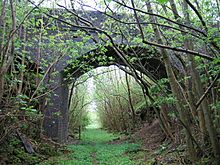Notgrove Railway Cutting facts for kids
| Site of Special Scientific Interest | |

Notgrove Railway Cutting
|
|
| Area of Search | Gloucestershire |
|---|---|
| Coordinates | 51°53′13″N 1°52′33″W / 51.887042°N 1.875726°W |
| Interest | Geological |
| Area | 1.7 hectare |
| Notification | 1974 |
Notgrove Railway Cutting is a special place in Gloucestershire, England. It's a protected area because of its amazing rocks and fossils. This site is known as a Site of Special Scientific Interest (SSSI) for its geology, meaning it's really important for understanding Earth's history.
It was officially recognized as an SSSI in 1974. This cutting is also listed as a Key Wildlife Site (KWS) and a Regionally Important Geological Site (RIGS). This means it's important for both wildlife and geology in the local area.
Contents
Exploring Notgrove Railway Cutting
This special location is found near the villages of Notgrove and Salperton. It's located within the beautiful Cotswolds Area of Outstanding Natural Beauty. Notgrove Railway Cutting is famous among geologists. It shows clear examples of rocks from a time called the Middle Jurassic period.
Layers of Ancient Rock
At Notgrove, you can see different layers of rock that tell a story about Earth's past. The lowest rock layer you can spot is called the Notgrove Freestone. This is a type of limestone.
Above the Notgrove Freestone, there's a cool feature called a hardground. This is a thin, very tough layer of limestone. It formed when the environment changed a long, long time ago. Think of it like a hardened ancient seafloor!
Discovering the Clypeus Grit
On top of the hardground, you'll find a rock layer known as the Upper Trigonia Grit. Even higher up, there's about 12 meters (almost 40 feet) of rock called the Clypeus Grit. This section of Clypeus Grit is considered the best and most complete example in the entire Cotswolds area.
It's super important for scientists who study rocks and Earth's history.
Fossils and Past Life
The rocks at Notgrove Railway Cutting are full of amazing fossils. These are the preserved remains of ancient plants and animals. Scientists have found many different kinds of fossils here, including important ammonites. Ammonites were sea creatures with spiral shells that lived millions of years ago.
Because of these rich fossil finds and the clear rock layers, Notgrove Railway Cutting is very important for geological research across the country. It helps us learn about what the Earth was like in the Middle Jurassic period.

